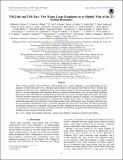TOI-216b and TOI-216 c: two warm, large exoplanets in or slightly wide of the 2:1 orbital resonance
Author(s)
Huang, Chelsea; Sha, Lizhou; Ricker, George R.; Vanderspek, Roland K.; Seager, Sara; Daylan, Tansu; Dynes, Scott; Yu, Liang; ... Show more Show less
DownloadPublished version (1.604Mb)
Publisher Policy
Publisher Policy
Article is made available in accordance with the publisher's policy and may be subject to US copyright law. Please refer to the publisher's site for terms of use.
Terms of use
Metadata
Show full item recordAbstract
© 2019. The American Astronomical Society. All rights reserved. Warm, large exoplanets with 10-100 day orbital periods pose a major challenge to our understanding of how planetary systems form and evolve. Although high eccentricity tidal migration has been invoked to explain their proximity to their host stars, a handful reside in or near orbital resonance with nearby planets, suggesting a gentler history of in situ formation or disk migration. Here we confirm and characterize a pair of warm, large exoplanets discovered by the TESS Mission orbiting K-dwarf TOI-216. Our analysis includes additional transits and transit exclusion windows observed via ground-based follow-up. We find two families of solutions, one corresponding to a sub-Saturn-mass planet accompanied by a Neptune-mass planet and the other to a Jupiter in resonance with a sub-Saturn-mass planet. We prefer the second solution based on the orbital period ratio, the planet radii, the lower free eccentricities, and libration of the 2:1 resonant argument, but cannot rule out the first. The free eccentricities and mutual inclination are compatible with stirring by other, undetected planets in the system, particularly for the second solution. We discuss prospects for better constraints on the planets' properties and orbits through follow-up, including transits observed from the ground.
Date issued
2019-08Department
Massachusetts Institute of Technology. Department of Physics; MIT Kavli Institute for Astrophysics and Space Research; Massachusetts Institute of Technology. Department of Earth, Atmospheric, and Planetary Sciences; Massachusetts Institute of Technology. Department of Aeronautics and AstronauticsJournal
Astronomical journal
Publisher
American Astronomical Society
Citation
Dawson, Rebekah I., et al., "TOI-216b and TOI-216 c: two warm, large exoplanets in or slightly wide of the 2:1 orbital resonance." Astronomical journal 158, 2 (August 2019): no. 65 doi 10.3847/1538-3881/AB24BA ©2019 Author(s)
Version: Final published version
ISSN
1538-3881